Vaping in Public Places: Should it be Allowed or Banned?
VerifiedAdded on 2023/04/22
|20
|4201
|410
AI Summary
This research study examines the pros and cons of vaping in public places. It includes a critical review of key references related to the regulation of vaping, ban of e-cigarettes in enclosed public spaces, and motivational factors for vaping. The research project specification includes objectives, appropriate plan and procedure, and proposed research investigation. The study also covers data collection, sampling, and data analysis. The questionnaire includes questions related to awareness of electronic cigarettes, acceptability of vaping in public places, and opinions on banning vaping in public places.
Contribute Materials
Your contribution can guide someone’s learning journey. Share your
documents today.

RESEARCH
PROJECT
PROJECT
Secure Best Marks with AI Grader
Need help grading? Try our AI Grader for instant feedback on your assignments.
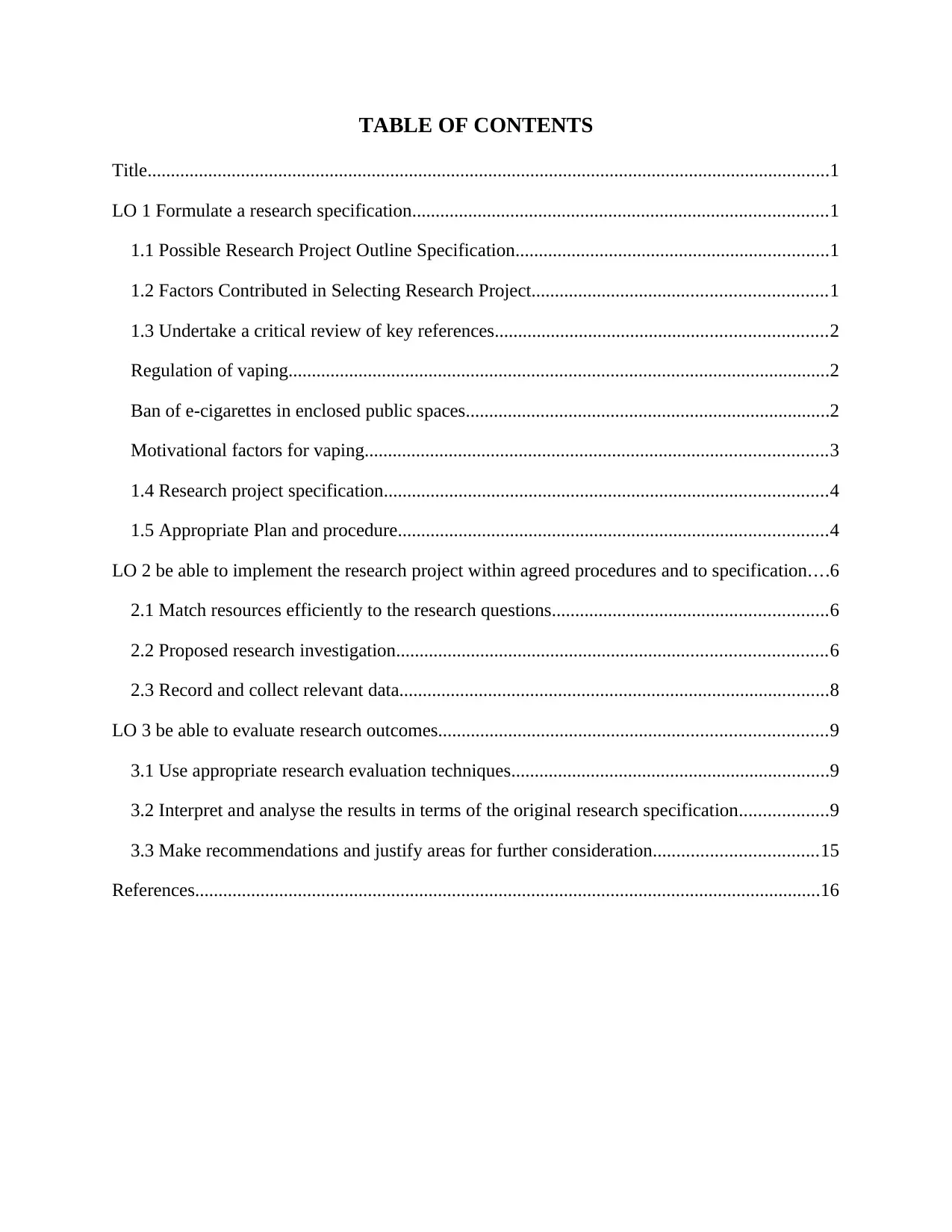
TABLE OF CONTENTS
Title..................................................................................................................................................1
LO 1 Formulate a research specification.........................................................................................1
1.1 Possible Research Project Outline Specification...................................................................1
1.2 Factors Contributed in Selecting Research Project...............................................................1
1.3 Undertake a critical review of key references.......................................................................2
Regulation of vaping....................................................................................................................2
Ban of e-cigarettes in enclosed public spaces..............................................................................2
Motivational factors for vaping...................................................................................................3
1.4 Research project specification...............................................................................................4
1.5 Appropriate Plan and procedure............................................................................................4
LO 2 be able to implement the research project within agreed procedures and to specification....6
2.1 Match resources efficiently to the research questions...........................................................6
2.2 Proposed research investigation............................................................................................6
2.3 Record and collect relevant data............................................................................................8
LO 3 be able to evaluate research outcomes...................................................................................9
3.1 Use appropriate research evaluation techniques....................................................................9
3.2 Interpret and analyse the results in terms of the original research specification...................9
3.3 Make recommendations and justify areas for further consideration...................................15
References......................................................................................................................................16
Title..................................................................................................................................................1
LO 1 Formulate a research specification.........................................................................................1
1.1 Possible Research Project Outline Specification...................................................................1
1.2 Factors Contributed in Selecting Research Project...............................................................1
1.3 Undertake a critical review of key references.......................................................................2
Regulation of vaping....................................................................................................................2
Ban of e-cigarettes in enclosed public spaces..............................................................................2
Motivational factors for vaping...................................................................................................3
1.4 Research project specification...............................................................................................4
1.5 Appropriate Plan and procedure............................................................................................4
LO 2 be able to implement the research project within agreed procedures and to specification....6
2.1 Match resources efficiently to the research questions...........................................................6
2.2 Proposed research investigation............................................................................................6
2.3 Record and collect relevant data............................................................................................8
LO 3 be able to evaluate research outcomes...................................................................................9
3.1 Use appropriate research evaluation techniques....................................................................9
3.2 Interpret and analyse the results in terms of the original research specification...................9
3.3 Make recommendations and justify areas for further consideration...................................15
References......................................................................................................................................16
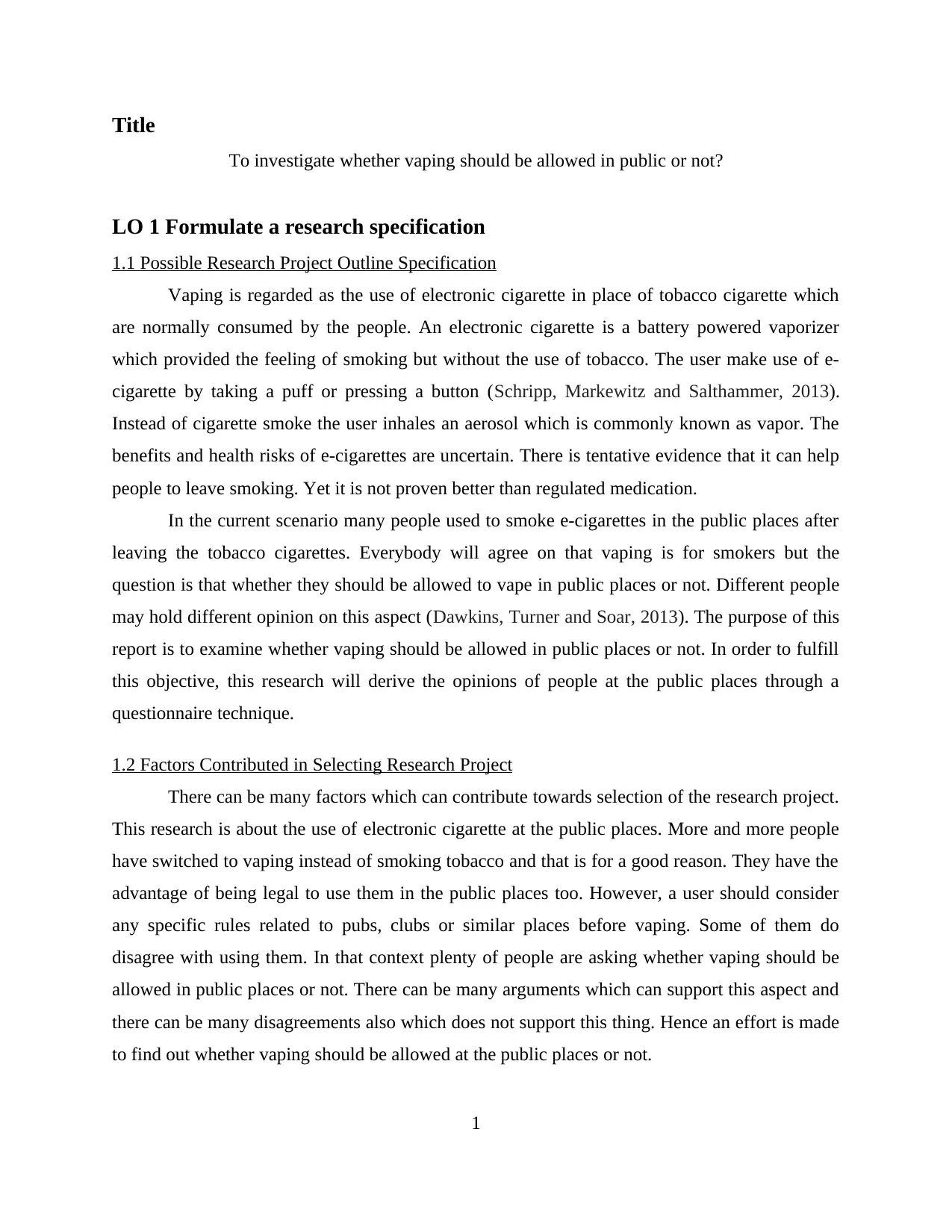
Title
To investigate whether vaping should be allowed in public or not?
LO 1 Formulate a research specification
1.1 Possible Research Project Outline Specification
Vaping is regarded as the use of electronic cigarette in place of tobacco cigarette which
are normally consumed by the people. An electronic cigarette is a battery powered vaporizer
which provided the feeling of smoking but without the use of tobacco. The user make use of e-
cigarette by taking a puff or pressing a button (Schripp, Markewitz and Salthammer, 2013).
Instead of cigarette smoke the user inhales an aerosol which is commonly known as vapor. The
benefits and health risks of e-cigarettes are uncertain. There is tentative evidence that it can help
people to leave smoking. Yet it is not proven better than regulated medication.
In the current scenario many people used to smoke e-cigarettes in the public places after
leaving the tobacco cigarettes. Everybody will agree on that vaping is for smokers but the
question is that whether they should be allowed to vape in public places or not. Different people
may hold different opinion on this aspect (Dawkins, Turner and Soar, 2013). The purpose of this
report is to examine whether vaping should be allowed in public places or not. In order to fulfill
this objective, this research will derive the opinions of people at the public places through a
questionnaire technique.
1.2 Factors Contributed in Selecting Research Project
There can be many factors which can contribute towards selection of the research project.
This research is about the use of electronic cigarette at the public places. More and more people
have switched to vaping instead of smoking tobacco and that is for a good reason. They have the
advantage of being legal to use them in the public places too. However, a user should consider
any specific rules related to pubs, clubs or similar places before vaping. Some of them do
disagree with using them. In that context plenty of people are asking whether vaping should be
allowed in public places or not. There can be many arguments which can support this aspect and
there can be many disagreements also which does not support this thing. Hence an effort is made
to find out whether vaping should be allowed at the public places or not.
1
To investigate whether vaping should be allowed in public or not?
LO 1 Formulate a research specification
1.1 Possible Research Project Outline Specification
Vaping is regarded as the use of electronic cigarette in place of tobacco cigarette which
are normally consumed by the people. An electronic cigarette is a battery powered vaporizer
which provided the feeling of smoking but without the use of tobacco. The user make use of e-
cigarette by taking a puff or pressing a button (Schripp, Markewitz and Salthammer, 2013).
Instead of cigarette smoke the user inhales an aerosol which is commonly known as vapor. The
benefits and health risks of e-cigarettes are uncertain. There is tentative evidence that it can help
people to leave smoking. Yet it is not proven better than regulated medication.
In the current scenario many people used to smoke e-cigarettes in the public places after
leaving the tobacco cigarettes. Everybody will agree on that vaping is for smokers but the
question is that whether they should be allowed to vape in public places or not. Different people
may hold different opinion on this aspect (Dawkins, Turner and Soar, 2013). The purpose of this
report is to examine whether vaping should be allowed in public places or not. In order to fulfill
this objective, this research will derive the opinions of people at the public places through a
questionnaire technique.
1.2 Factors Contributed in Selecting Research Project
There can be many factors which can contribute towards selection of the research project.
This research is about the use of electronic cigarette at the public places. More and more people
have switched to vaping instead of smoking tobacco and that is for a good reason. They have the
advantage of being legal to use them in the public places too. However, a user should consider
any specific rules related to pubs, clubs or similar places before vaping. Some of them do
disagree with using them. In that context plenty of people are asking whether vaping should be
allowed in public places or not. There can be many arguments which can support this aspect and
there can be many disagreements also which does not support this thing. Hence an effort is made
to find out whether vaping should be allowed at the public places or not.
1
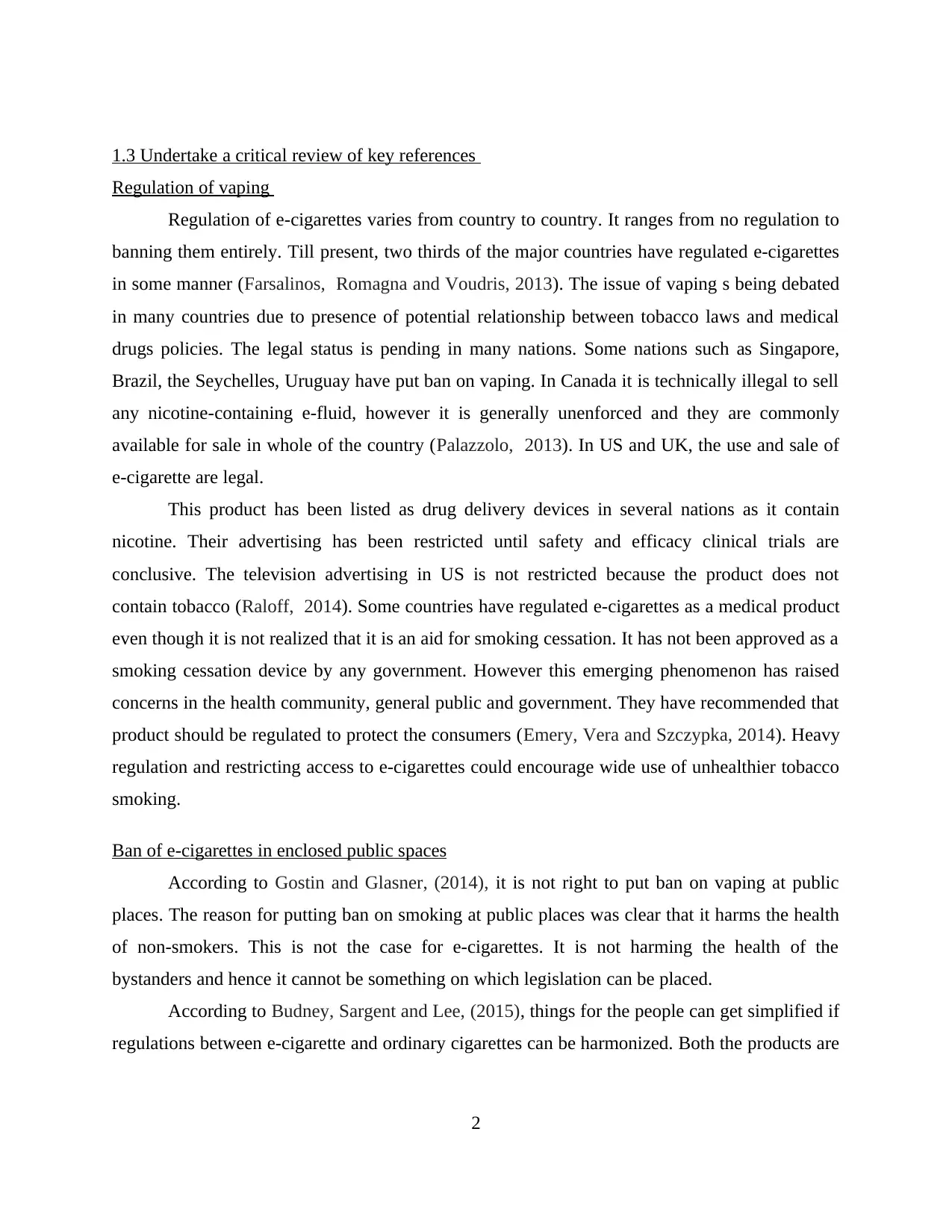
1.3 Undertake a critical review of key references
Regulation of vaping
Regulation of e-cigarettes varies from country to country. It ranges from no regulation to
banning them entirely. Till present, two thirds of the major countries have regulated e-cigarettes
in some manner (Farsalinos, Romagna and Voudris, 2013). The issue of vaping s being debated
in many countries due to presence of potential relationship between tobacco laws and medical
drugs policies. The legal status is pending in many nations. Some nations such as Singapore,
Brazil, the Seychelles, Uruguay have put ban on vaping. In Canada it is technically illegal to sell
any nicotine-containing e-fluid, however it is generally unenforced and they are commonly
available for sale in whole of the country (Palazzolo, 2013). In US and UK, the use and sale of
e-cigarette are legal.
This product has been listed as drug delivery devices in several nations as it contain
nicotine. Their advertising has been restricted until safety and efficacy clinical trials are
conclusive. The television advertising in US is not restricted because the product does not
contain tobacco (Raloff, 2014). Some countries have regulated e-cigarettes as a medical product
even though it is not realized that it is an aid for smoking cessation. It has not been approved as a
smoking cessation device by any government. However this emerging phenomenon has raised
concerns in the health community, general public and government. They have recommended that
product should be regulated to protect the consumers (Emery, Vera and Szczypka, 2014). Heavy
regulation and restricting access to e-cigarettes could encourage wide use of unhealthier tobacco
smoking.
Ban of e-cigarettes in enclosed public spaces
According to Gostin and Glasner, (2014), it is not right to put ban on vaping at public
places. The reason for putting ban on smoking at public places was clear that it harms the health
of non-smokers. This is not the case for e-cigarettes. It is not harming the health of the
bystanders and hence it cannot be something on which legislation can be placed.
According to Budney, Sargent and Lee, (2015), things for the people can get simplified if
regulations between e-cigarette and ordinary cigarettes can be harmonized. Both the products are
2
Regulation of vaping
Regulation of e-cigarettes varies from country to country. It ranges from no regulation to
banning them entirely. Till present, two thirds of the major countries have regulated e-cigarettes
in some manner (Farsalinos, Romagna and Voudris, 2013). The issue of vaping s being debated
in many countries due to presence of potential relationship between tobacco laws and medical
drugs policies. The legal status is pending in many nations. Some nations such as Singapore,
Brazil, the Seychelles, Uruguay have put ban on vaping. In Canada it is technically illegal to sell
any nicotine-containing e-fluid, however it is generally unenforced and they are commonly
available for sale in whole of the country (Palazzolo, 2013). In US and UK, the use and sale of
e-cigarette are legal.
This product has been listed as drug delivery devices in several nations as it contain
nicotine. Their advertising has been restricted until safety and efficacy clinical trials are
conclusive. The television advertising in US is not restricted because the product does not
contain tobacco (Raloff, 2014). Some countries have regulated e-cigarettes as a medical product
even though it is not realized that it is an aid for smoking cessation. It has not been approved as a
smoking cessation device by any government. However this emerging phenomenon has raised
concerns in the health community, general public and government. They have recommended that
product should be regulated to protect the consumers (Emery, Vera and Szczypka, 2014). Heavy
regulation and restricting access to e-cigarettes could encourage wide use of unhealthier tobacco
smoking.
Ban of e-cigarettes in enclosed public spaces
According to Gostin and Glasner, (2014), it is not right to put ban on vaping at public
places. The reason for putting ban on smoking at public places was clear that it harms the health
of non-smokers. This is not the case for e-cigarettes. It is not harming the health of the
bystanders and hence it cannot be something on which legislation can be placed.
According to Budney, Sargent and Lee, (2015), things for the people can get simplified if
regulations between e-cigarette and ordinary cigarettes can be harmonized. Both the products are
2
Secure Best Marks with AI Grader
Need help grading? Try our AI Grader for instant feedback on your assignments.
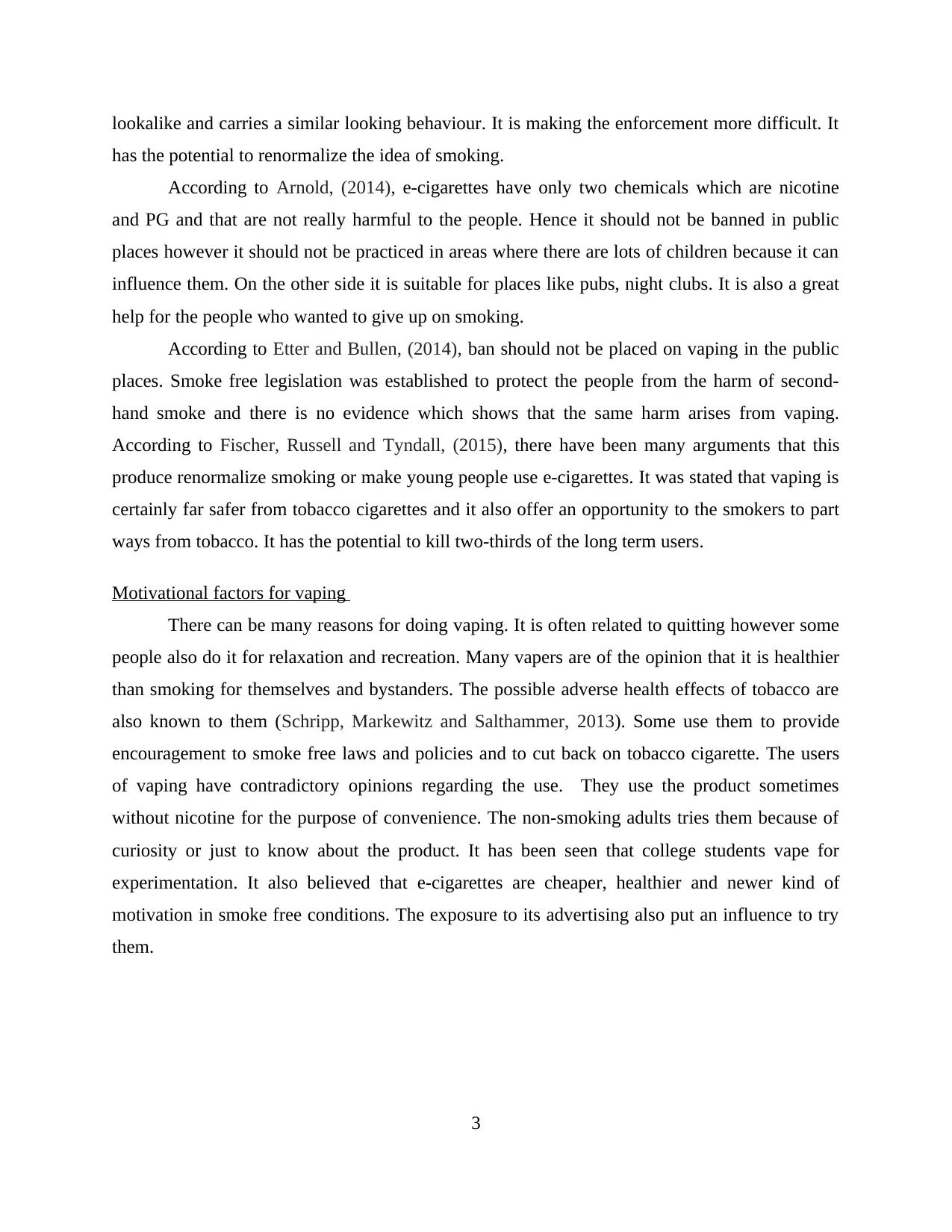
lookalike and carries a similar looking behaviour. It is making the enforcement more difficult. It
has the potential to renormalize the idea of smoking.
According to Arnold, (2014), e-cigarettes have only two chemicals which are nicotine
and PG and that are not really harmful to the people. Hence it should not be banned in public
places however it should not be practiced in areas where there are lots of children because it can
influence them. On the other side it is suitable for places like pubs, night clubs. It is also a great
help for the people who wanted to give up on smoking.
According to Etter and Bullen, (2014), ban should not be placed on vaping in the public
places. Smoke free legislation was established to protect the people from the harm of second-
hand smoke and there is no evidence which shows that the same harm arises from vaping.
According to Fischer, Russell and Tyndall, (2015), there have been many arguments that this
produce renormalize smoking or make young people use e-cigarettes. It was stated that vaping is
certainly far safer from tobacco cigarettes and it also offer an opportunity to the smokers to part
ways from tobacco. It has the potential to kill two-thirds of the long term users.
Motivational factors for vaping
There can be many reasons for doing vaping. It is often related to quitting however some
people also do it for relaxation and recreation. Many vapers are of the opinion that it is healthier
than smoking for themselves and bystanders. The possible adverse health effects of tobacco are
also known to them (Schripp, Markewitz and Salthammer, 2013). Some use them to provide
encouragement to smoke free laws and policies and to cut back on tobacco cigarette. The users
of vaping have contradictory opinions regarding the use. They use the product sometimes
without nicotine for the purpose of convenience. The non-smoking adults tries them because of
curiosity or just to know about the product. It has been seen that college students vape for
experimentation. It also believed that e-cigarettes are cheaper, healthier and newer kind of
motivation in smoke free conditions. The exposure to its advertising also put an influence to try
them.
3
has the potential to renormalize the idea of smoking.
According to Arnold, (2014), e-cigarettes have only two chemicals which are nicotine
and PG and that are not really harmful to the people. Hence it should not be banned in public
places however it should not be practiced in areas where there are lots of children because it can
influence them. On the other side it is suitable for places like pubs, night clubs. It is also a great
help for the people who wanted to give up on smoking.
According to Etter and Bullen, (2014), ban should not be placed on vaping in the public
places. Smoke free legislation was established to protect the people from the harm of second-
hand smoke and there is no evidence which shows that the same harm arises from vaping.
According to Fischer, Russell and Tyndall, (2015), there have been many arguments that this
produce renormalize smoking or make young people use e-cigarettes. It was stated that vaping is
certainly far safer from tobacco cigarettes and it also offer an opportunity to the smokers to part
ways from tobacco. It has the potential to kill two-thirds of the long term users.
Motivational factors for vaping
There can be many reasons for doing vaping. It is often related to quitting however some
people also do it for relaxation and recreation. Many vapers are of the opinion that it is healthier
than smoking for themselves and bystanders. The possible adverse health effects of tobacco are
also known to them (Schripp, Markewitz and Salthammer, 2013). Some use them to provide
encouragement to smoke free laws and policies and to cut back on tobacco cigarette. The users
of vaping have contradictory opinions regarding the use. They use the product sometimes
without nicotine for the purpose of convenience. The non-smoking adults tries them because of
curiosity or just to know about the product. It has been seen that college students vape for
experimentation. It also believed that e-cigarettes are cheaper, healthier and newer kind of
motivation in smoke free conditions. The exposure to its advertising also put an influence to try
them.
3
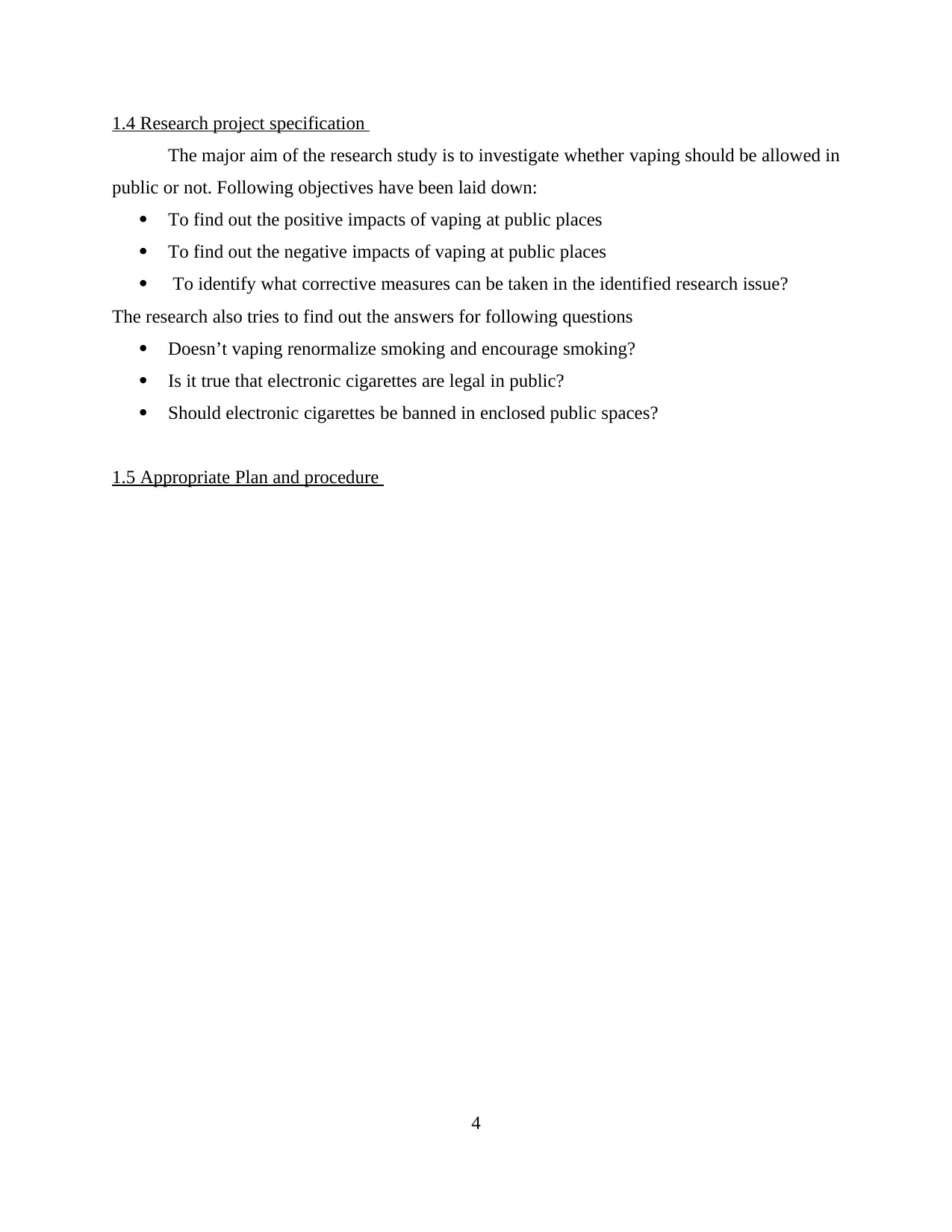
1.4 Research project specification
The major aim of the research study is to investigate whether vaping should be allowed in
public or not. Following objectives have been laid down:
To find out the positive impacts of vaping at public places
To find out the negative impacts of vaping at public places
To identify what corrective measures can be taken in the identified research issue?
The research also tries to find out the answers for following questions
Doesn’t vaping renormalize smoking and encourage smoking?
Is it true that electronic cigarettes are legal in public?
Should electronic cigarettes be banned in enclosed public spaces?
1.5 Appropriate Plan and procedure
4
The major aim of the research study is to investigate whether vaping should be allowed in
public or not. Following objectives have been laid down:
To find out the positive impacts of vaping at public places
To find out the negative impacts of vaping at public places
To identify what corrective measures can be taken in the identified research issue?
The research also tries to find out the answers for following questions
Doesn’t vaping renormalize smoking and encourage smoking?
Is it true that electronic cigarettes are legal in public?
Should electronic cigarettes be banned in enclosed public spaces?
1.5 Appropriate Plan and procedure
4
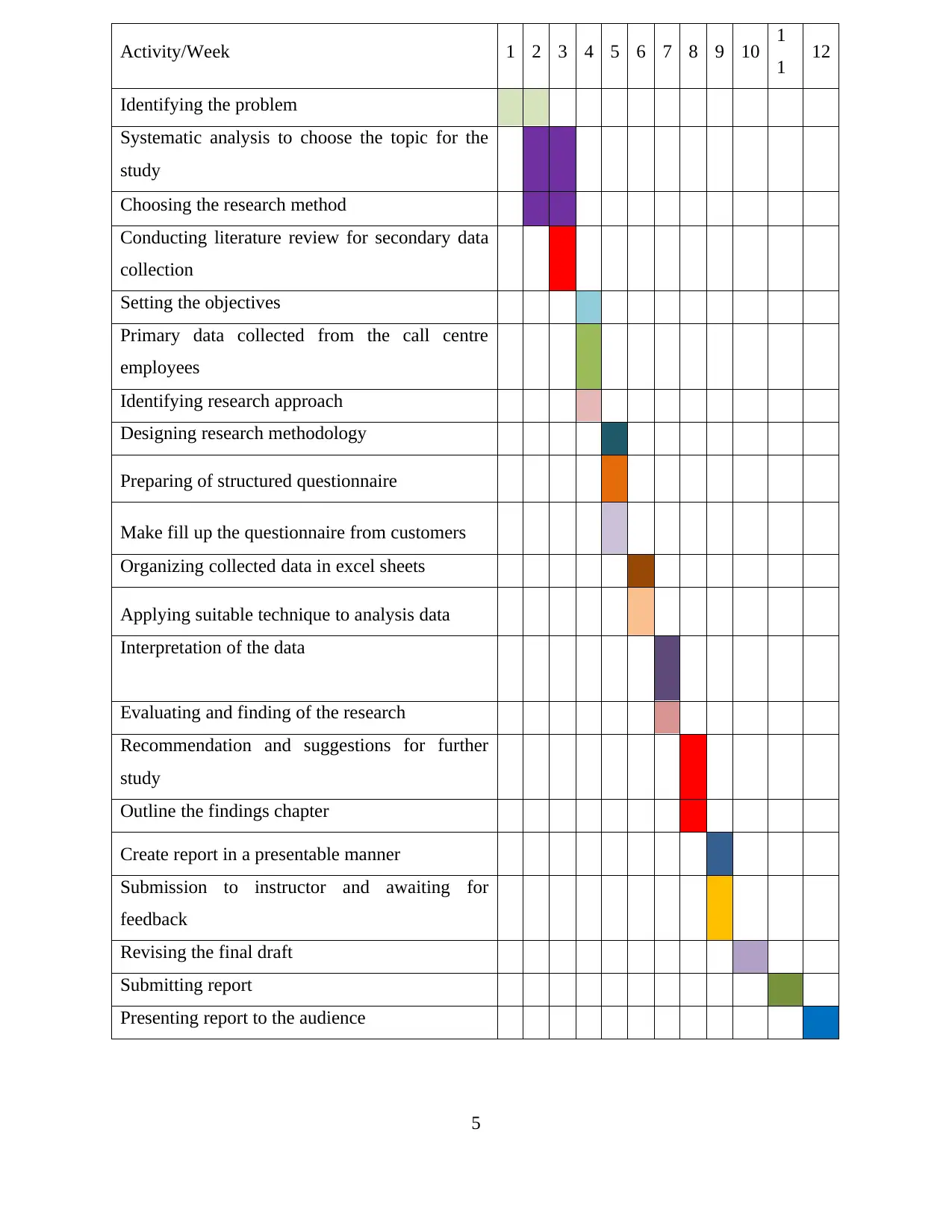
5
Activity/Week 1 2 3 4 5 6 7 8 9 10 1
1 12
Identifying the problem
Systematic analysis to choose the topic for the
study
Choosing the research method
Conducting literature review for secondary data
collection
Setting the objectives
Primary data collected from the call centre
employees
Identifying research approach
Designing research methodology
Preparing of structured questionnaire
Make fill up the questionnaire from customers
Organizing collected data in excel sheets
Applying suitable technique to analysis data
Interpretation of the data
Evaluating and finding of the research
Recommendation and suggestions for further
study
Outline the findings chapter
Create report in a presentable manner
Submission to instructor and awaiting for
feedback
Revising the final draft
Submitting report
Presenting report to the audience
Activity/Week 1 2 3 4 5 6 7 8 9 10 1
1 12
Identifying the problem
Systematic analysis to choose the topic for the
study
Choosing the research method
Conducting literature review for secondary data
collection
Setting the objectives
Primary data collected from the call centre
employees
Identifying research approach
Designing research methodology
Preparing of structured questionnaire
Make fill up the questionnaire from customers
Organizing collected data in excel sheets
Applying suitable technique to analysis data
Interpretation of the data
Evaluating and finding of the research
Recommendation and suggestions for further
study
Outline the findings chapter
Create report in a presentable manner
Submission to instructor and awaiting for
feedback
Revising the final draft
Submitting report
Presenting report to the audience
Paraphrase This Document
Need a fresh take? Get an instant paraphrase of this document with our AI Paraphraser
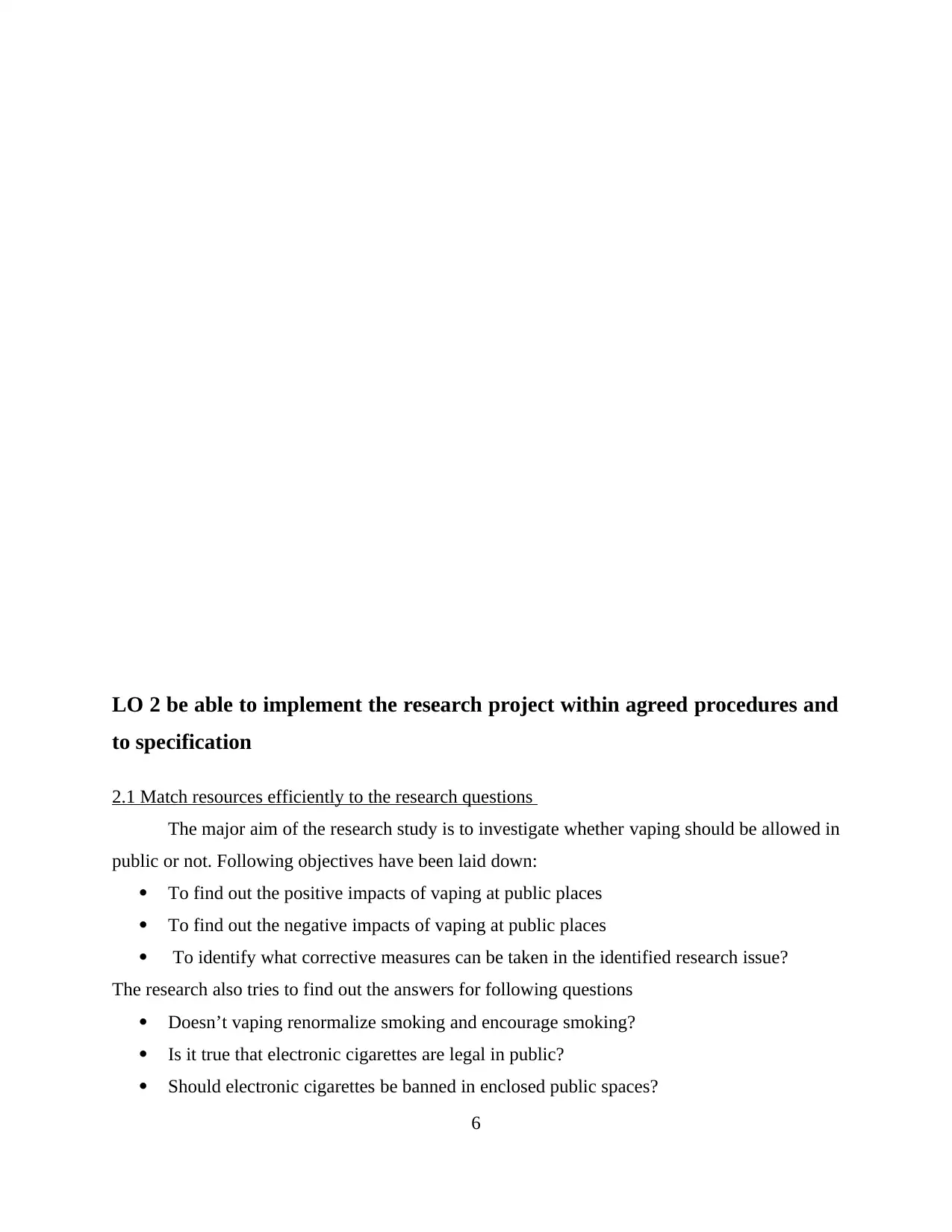
LO 2 be able to implement the research project within agreed procedures and
to specification
2.1 Match resources efficiently to the research questions
The major aim of the research study is to investigate whether vaping should be allowed in
public or not. Following objectives have been laid down:
To find out the positive impacts of vaping at public places
To find out the negative impacts of vaping at public places
To identify what corrective measures can be taken in the identified research issue?
The research also tries to find out the answers for following questions
Doesn’t vaping renormalize smoking and encourage smoking?
Is it true that electronic cigarettes are legal in public?
Should electronic cigarettes be banned in enclosed public spaces?
6
to specification
2.1 Match resources efficiently to the research questions
The major aim of the research study is to investigate whether vaping should be allowed in
public or not. Following objectives have been laid down:
To find out the positive impacts of vaping at public places
To find out the negative impacts of vaping at public places
To identify what corrective measures can be taken in the identified research issue?
The research also tries to find out the answers for following questions
Doesn’t vaping renormalize smoking and encourage smoking?
Is it true that electronic cigarettes are legal in public?
Should electronic cigarettes be banned in enclosed public spaces?
6
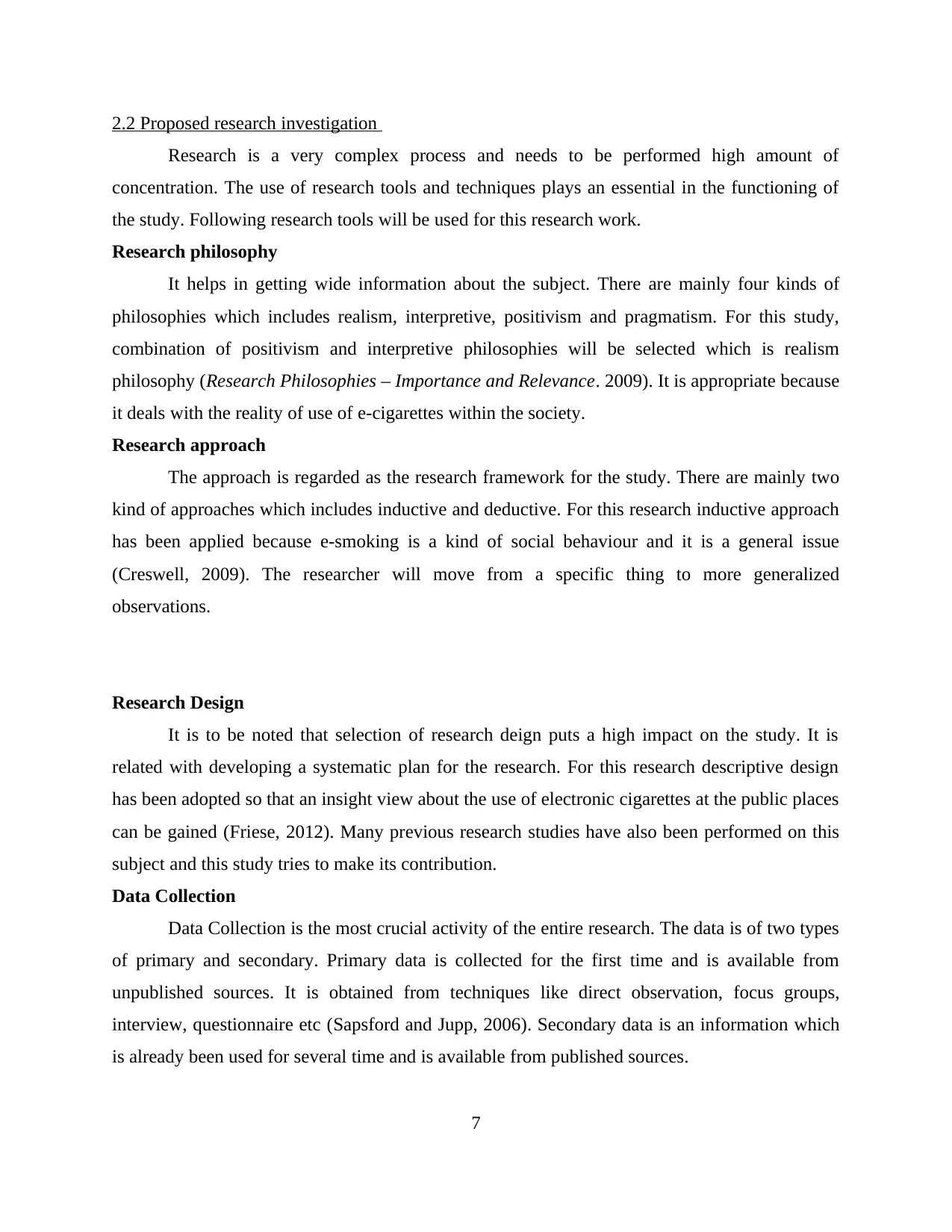
2.2 Proposed research investigation
Research is a very complex process and needs to be performed high amount of
concentration. The use of research tools and techniques plays an essential in the functioning of
the study. Following research tools will be used for this research work.
Research philosophy
It helps in getting wide information about the subject. There are mainly four kinds of
philosophies which includes realism, interpretive, positivism and pragmatism. For this study,
combination of positivism and interpretive philosophies will be selected which is realism
philosophy (Research Philosophies – Importance and Relevance. 2009). It is appropriate because
it deals with the reality of use of e-cigarettes within the society.
Research approach
The approach is regarded as the research framework for the study. There are mainly two
kind of approaches which includes inductive and deductive. For this research inductive approach
has been applied because e-smoking is a kind of social behaviour and it is a general issue
(Creswell, 2009). The researcher will move from a specific thing to more generalized
observations.
Research Design
It is to be noted that selection of research deign puts a high impact on the study. It is
related with developing a systematic plan for the research. For this research descriptive design
has been adopted so that an insight view about the use of electronic cigarettes at the public places
can be gained (Friese, 2012). Many previous research studies have also been performed on this
subject and this study tries to make its contribution.
Data Collection
Data Collection is the most crucial activity of the entire research. The data is of two types
of primary and secondary. Primary data is collected for the first time and is available from
unpublished sources. It is obtained from techniques like direct observation, focus groups,
interview, questionnaire etc (Sapsford and Jupp, 2006). Secondary data is an information which
is already been used for several time and is available from published sources.
7
Research is a very complex process and needs to be performed high amount of
concentration. The use of research tools and techniques plays an essential in the functioning of
the study. Following research tools will be used for this research work.
Research philosophy
It helps in getting wide information about the subject. There are mainly four kinds of
philosophies which includes realism, interpretive, positivism and pragmatism. For this study,
combination of positivism and interpretive philosophies will be selected which is realism
philosophy (Research Philosophies – Importance and Relevance. 2009). It is appropriate because
it deals with the reality of use of e-cigarettes within the society.
Research approach
The approach is regarded as the research framework for the study. There are mainly two
kind of approaches which includes inductive and deductive. For this research inductive approach
has been applied because e-smoking is a kind of social behaviour and it is a general issue
(Creswell, 2009). The researcher will move from a specific thing to more generalized
observations.
Research Design
It is to be noted that selection of research deign puts a high impact on the study. It is
related with developing a systematic plan for the research. For this research descriptive design
has been adopted so that an insight view about the use of electronic cigarettes at the public places
can be gained (Friese, 2012). Many previous research studies have also been performed on this
subject and this study tries to make its contribution.
Data Collection
Data Collection is the most crucial activity of the entire research. The data is of two types
of primary and secondary. Primary data is collected for the first time and is available from
unpublished sources. It is obtained from techniques like direct observation, focus groups,
interview, questionnaire etc (Sapsford and Jupp, 2006). Secondary data is an information which
is already been used for several time and is available from published sources.
7
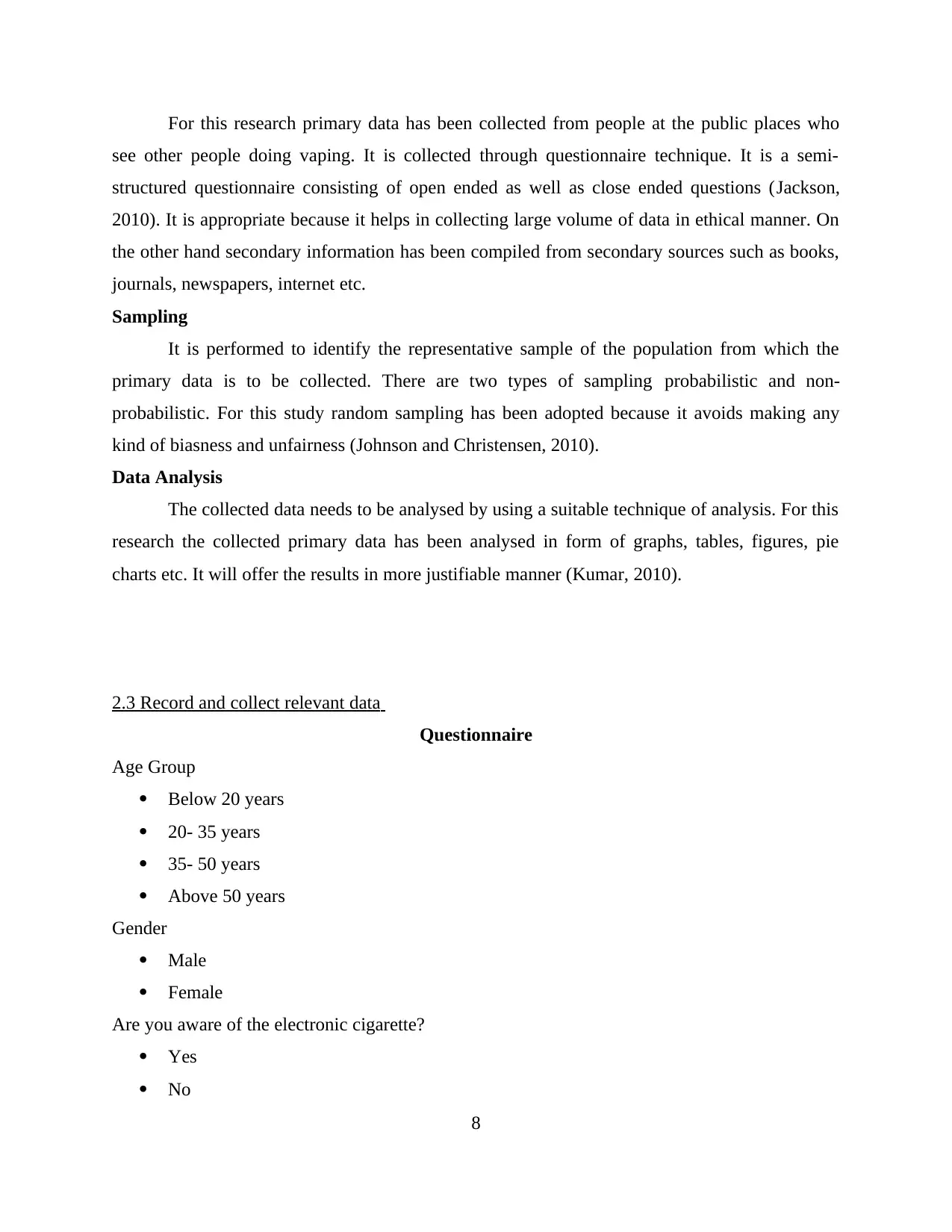
For this research primary data has been collected from people at the public places who
see other people doing vaping. It is collected through questionnaire technique. It is a semi-
structured questionnaire consisting of open ended as well as close ended questions (Jackson,
2010). It is appropriate because it helps in collecting large volume of data in ethical manner. On
the other hand secondary information has been compiled from secondary sources such as books,
journals, newspapers, internet etc.
Sampling
It is performed to identify the representative sample of the population from which the
primary data is to be collected. There are two types of sampling probabilistic and non-
probabilistic. For this study random sampling has been adopted because it avoids making any
kind of biasness and unfairness (Johnson and Christensen, 2010).
Data Analysis
The collected data needs to be analysed by using a suitable technique of analysis. For this
research the collected primary data has been analysed in form of graphs, tables, figures, pie
charts etc. It will offer the results in more justifiable manner (Kumar, 2010).
2.3 Record and collect relevant data
Questionnaire
Age Group
Below 20 years
20- 35 years
35- 50 years
Above 50 years
Gender
Male
Female
Are you aware of the electronic cigarette?
Yes
No
8
see other people doing vaping. It is collected through questionnaire technique. It is a semi-
structured questionnaire consisting of open ended as well as close ended questions (Jackson,
2010). It is appropriate because it helps in collecting large volume of data in ethical manner. On
the other hand secondary information has been compiled from secondary sources such as books,
journals, newspapers, internet etc.
Sampling
It is performed to identify the representative sample of the population from which the
primary data is to be collected. There are two types of sampling probabilistic and non-
probabilistic. For this study random sampling has been adopted because it avoids making any
kind of biasness and unfairness (Johnson and Christensen, 2010).
Data Analysis
The collected data needs to be analysed by using a suitable technique of analysis. For this
research the collected primary data has been analysed in form of graphs, tables, figures, pie
charts etc. It will offer the results in more justifiable manner (Kumar, 2010).
2.3 Record and collect relevant data
Questionnaire
Age Group
Below 20 years
20- 35 years
35- 50 years
Above 50 years
Gender
Male
Female
Are you aware of the electronic cigarette?
Yes
No
8
Secure Best Marks with AI Grader
Need help grading? Try our AI Grader for instant feedback on your assignments.
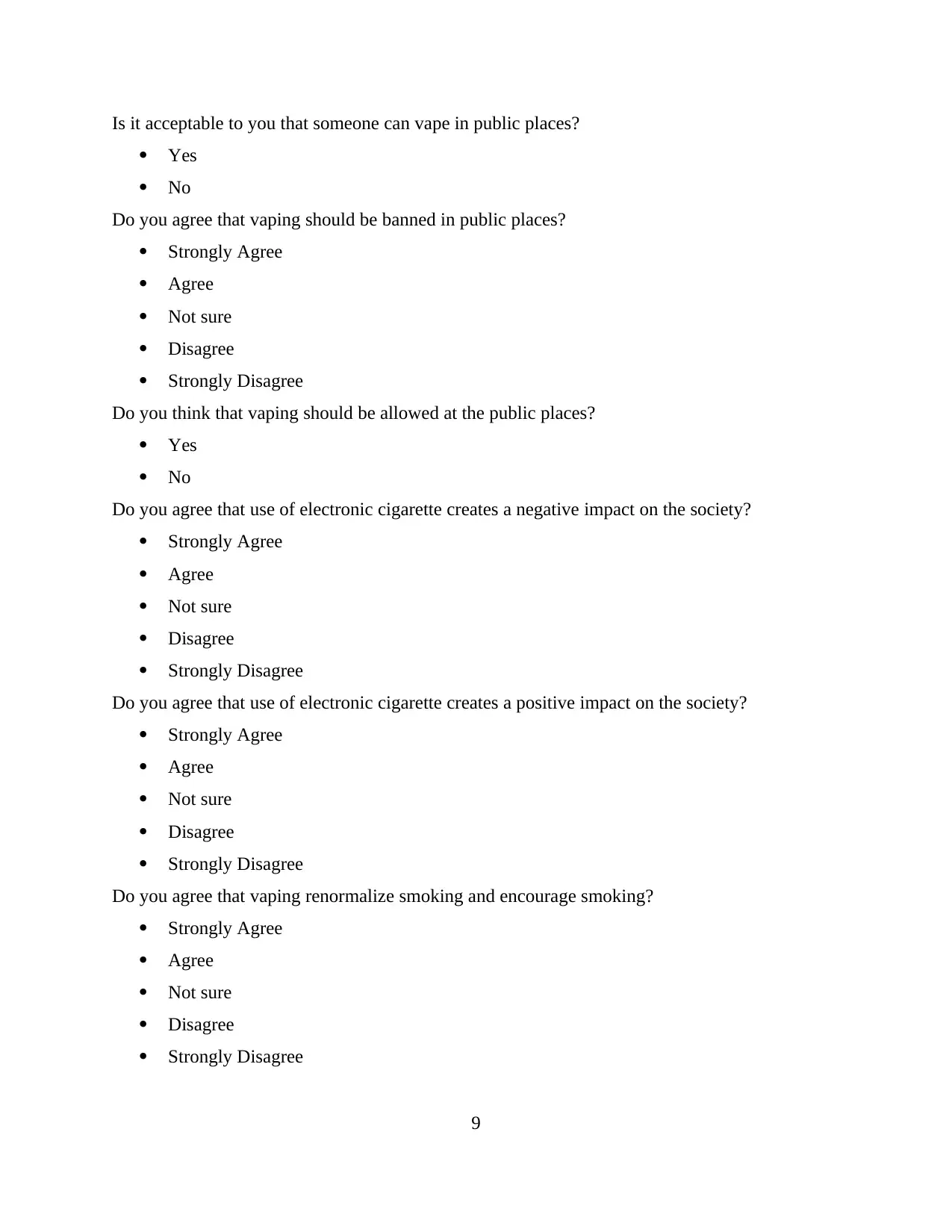
Is it acceptable to you that someone can vape in public places?
Yes
No
Do you agree that vaping should be banned in public places?
Strongly Agree
Agree
Not sure
Disagree
Strongly Disagree
Do you think that vaping should be allowed at the public places?
Yes
No
Do you agree that use of electronic cigarette creates a negative impact on the society?
Strongly Agree
Agree
Not sure
Disagree
Strongly Disagree
Do you agree that use of electronic cigarette creates a positive impact on the society?
Strongly Agree
Agree
Not sure
Disagree
Strongly Disagree
Do you agree that vaping renormalize smoking and encourage smoking?
Strongly Agree
Agree
Not sure
Disagree
Strongly Disagree
9
Yes
No
Do you agree that vaping should be banned in public places?
Strongly Agree
Agree
Not sure
Disagree
Strongly Disagree
Do you think that vaping should be allowed at the public places?
Yes
No
Do you agree that use of electronic cigarette creates a negative impact on the society?
Strongly Agree
Agree
Not sure
Disagree
Strongly Disagree
Do you agree that use of electronic cigarette creates a positive impact on the society?
Strongly Agree
Agree
Not sure
Disagree
Strongly Disagree
Do you agree that vaping renormalize smoking and encourage smoking?
Strongly Agree
Agree
Not sure
Disagree
Strongly Disagree
9
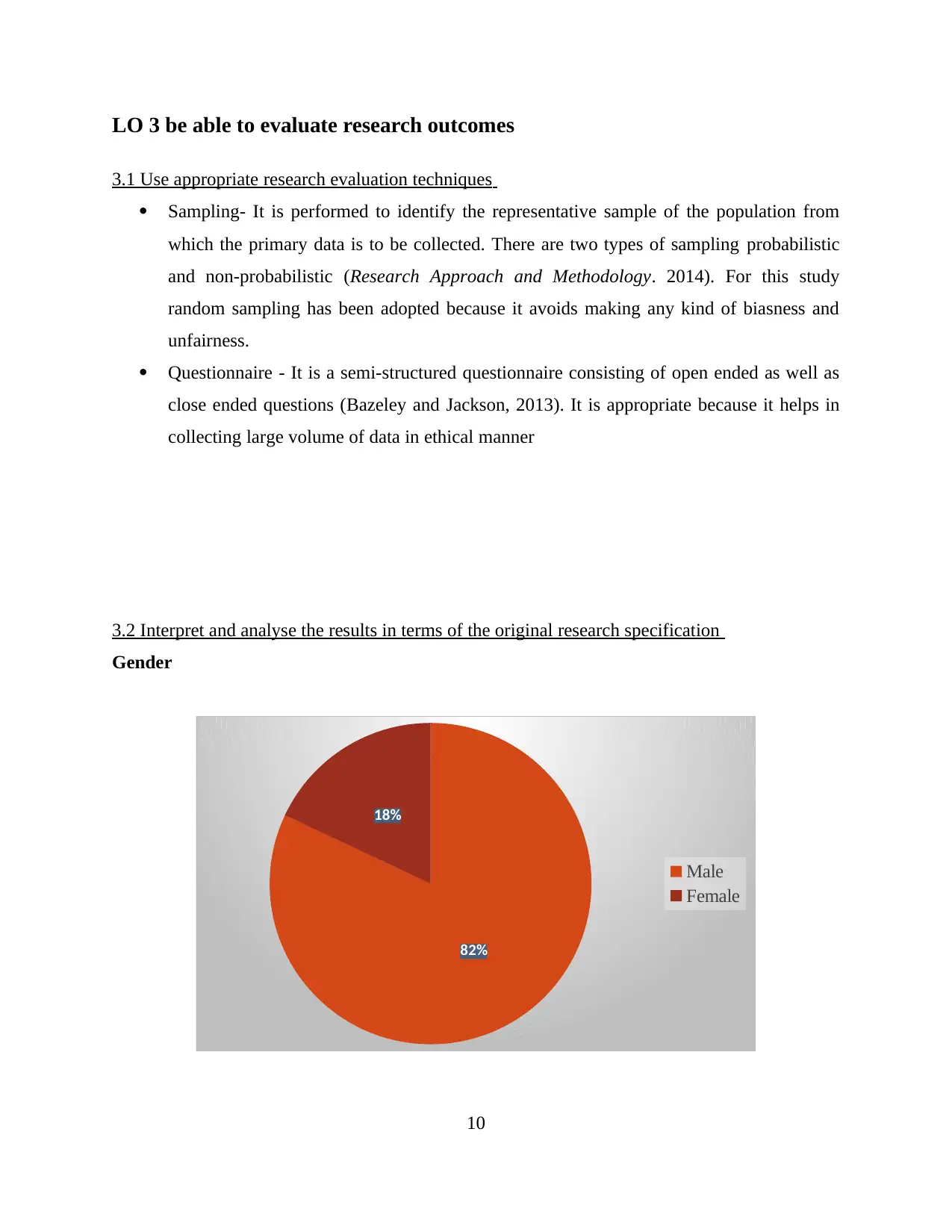
LO 3 be able to evaluate research outcomes
3.1 Use appropriate research evaluation techniques
Sampling- It is performed to identify the representative sample of the population from
which the primary data is to be collected. There are two types of sampling probabilistic
and non-probabilistic (Research Approach and Methodology. 2014). For this study
random sampling has been adopted because it avoids making any kind of biasness and
unfairness.
Questionnaire - It is a semi-structured questionnaire consisting of open ended as well as
close ended questions (Bazeley and Jackson, 2013). It is appropriate because it helps in
collecting large volume of data in ethical manner
3.2 Interpret and analyse the results in terms of the original research specification
Gender
82%
18%
Male
Female
10
3.1 Use appropriate research evaluation techniques
Sampling- It is performed to identify the representative sample of the population from
which the primary data is to be collected. There are two types of sampling probabilistic
and non-probabilistic (Research Approach and Methodology. 2014). For this study
random sampling has been adopted because it avoids making any kind of biasness and
unfairness.
Questionnaire - It is a semi-structured questionnaire consisting of open ended as well as
close ended questions (Bazeley and Jackson, 2013). It is appropriate because it helps in
collecting large volume of data in ethical manner
3.2 Interpret and analyse the results in terms of the original research specification
Gender
82%
18%
Male
Female
10
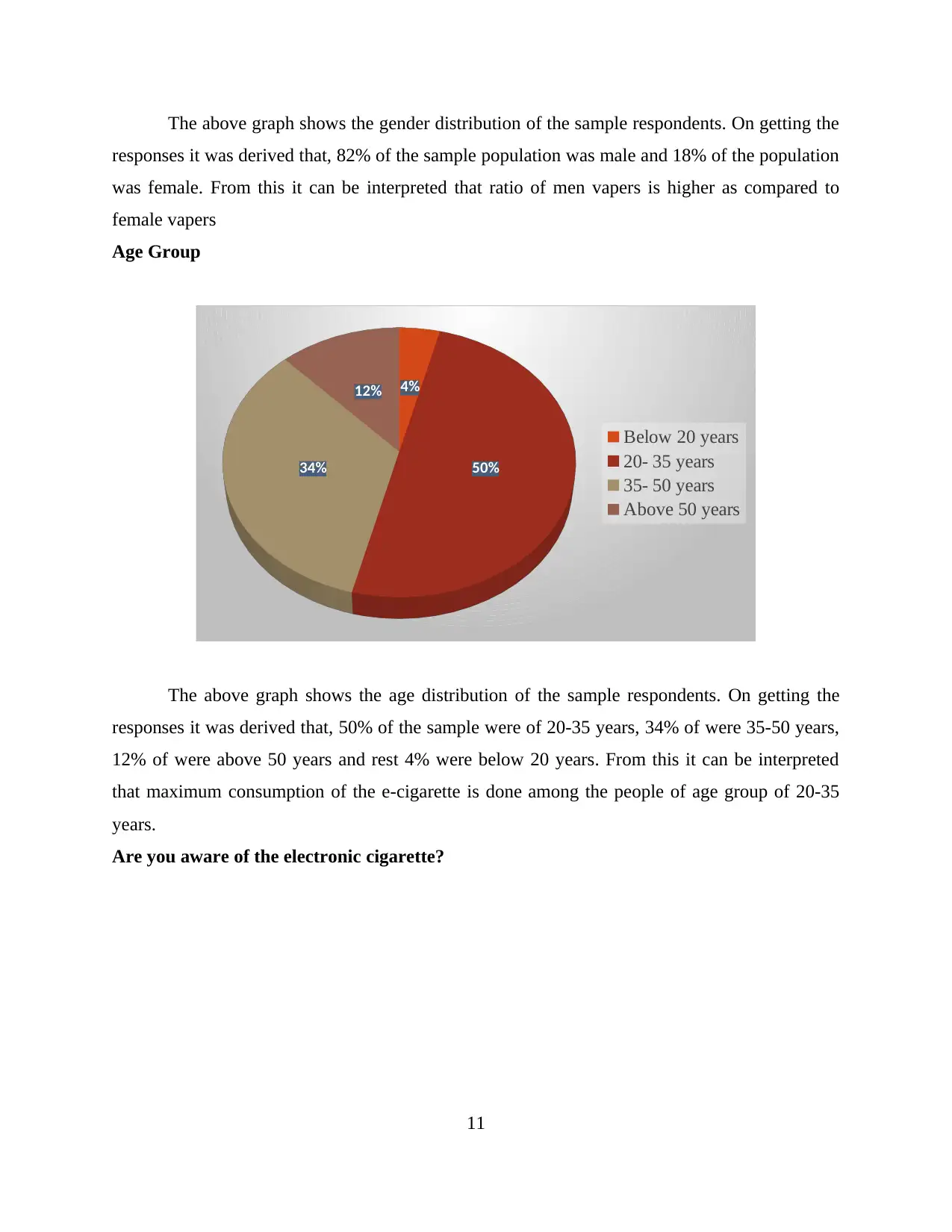
The above graph shows the gender distribution of the sample respondents. On getting the
responses it was derived that, 82% of the sample population was male and 18% of the population
was female. From this it can be interpreted that ratio of men vapers is higher as compared to
female vapers
Age Group
4%
50%34%
12%
Below 20 years
20- 35 years
35- 50 years
Above 50 years
The above graph shows the age distribution of the sample respondents. On getting the
responses it was derived that, 50% of the sample were of 20-35 years, 34% of were 35-50 years,
12% of were above 50 years and rest 4% were below 20 years. From this it can be interpreted
that maximum consumption of the e-cigarette is done among the people of age group of 20-35
years.
Are you aware of the electronic cigarette?
11
responses it was derived that, 82% of the sample population was male and 18% of the population
was female. From this it can be interpreted that ratio of men vapers is higher as compared to
female vapers
Age Group
4%
50%34%
12%
Below 20 years
20- 35 years
35- 50 years
Above 50 years
The above graph shows the age distribution of the sample respondents. On getting the
responses it was derived that, 50% of the sample were of 20-35 years, 34% of were 35-50 years,
12% of were above 50 years and rest 4% were below 20 years. From this it can be interpreted
that maximum consumption of the e-cigarette is done among the people of age group of 20-35
years.
Are you aware of the electronic cigarette?
11
Paraphrase This Document
Need a fresh take? Get an instant paraphrase of this document with our AI Paraphraser
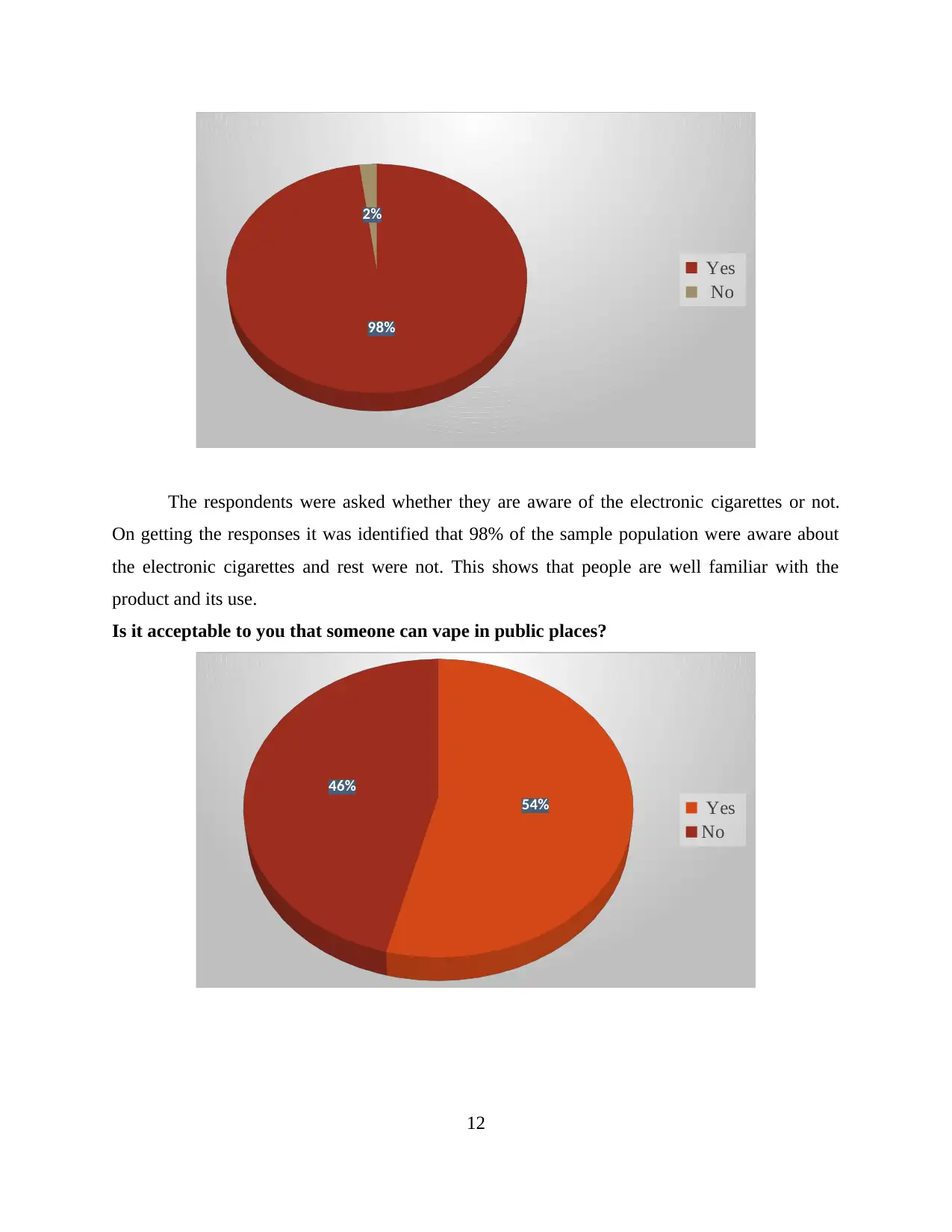
98%
2%
Yes
No
The respondents were asked whether they are aware of the electronic cigarettes or not.
On getting the responses it was identified that 98% of the sample population were aware about
the electronic cigarettes and rest were not. This shows that people are well familiar with the
product and its use.
Is it acceptable to you that someone can vape in public places?
54%
46%
Yes
No
12
2%
Yes
No
The respondents were asked whether they are aware of the electronic cigarettes or not.
On getting the responses it was identified that 98% of the sample population were aware about
the electronic cigarettes and rest were not. This shows that people are well familiar with the
product and its use.
Is it acceptable to you that someone can vape in public places?
54%
46%
Yes
No
12
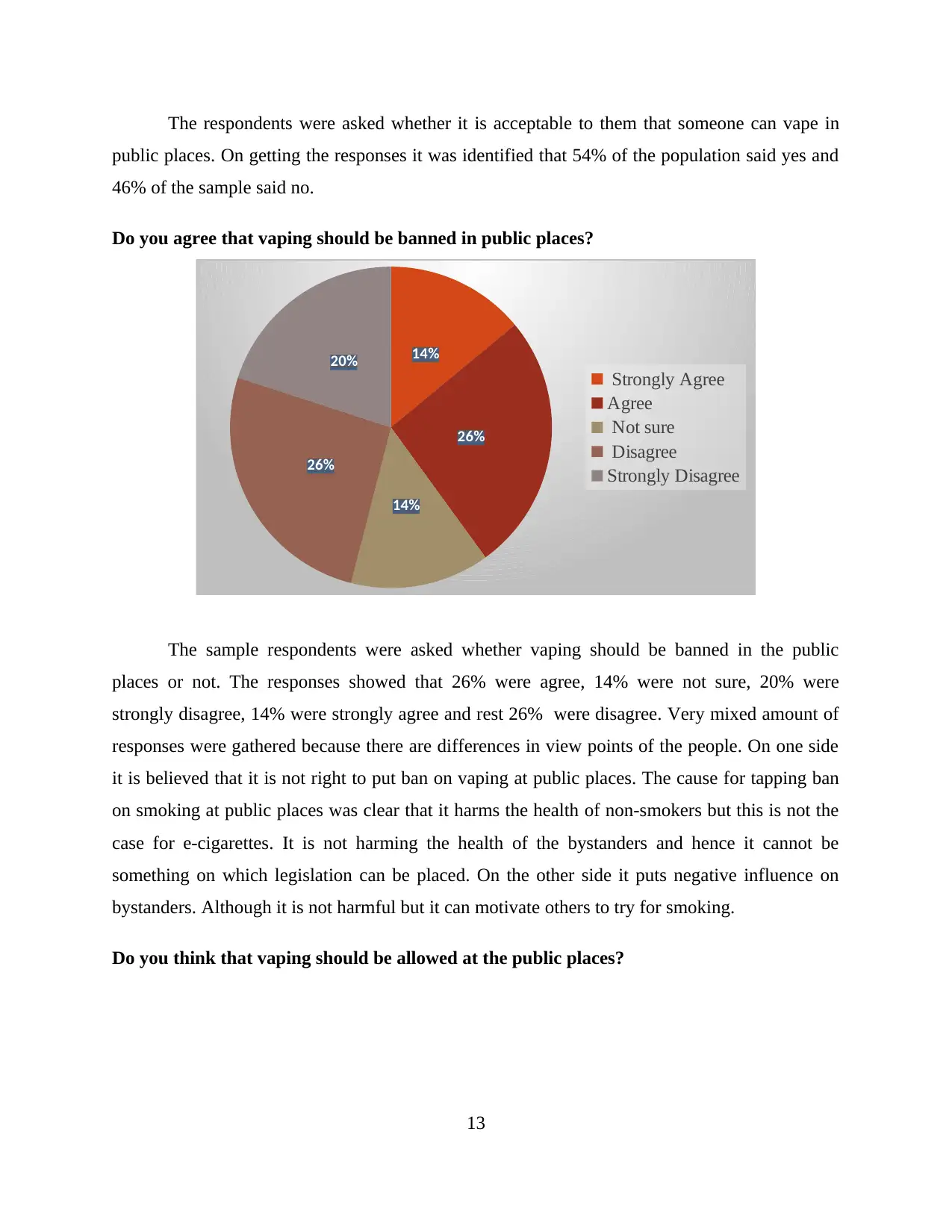
The respondents were asked whether it is acceptable to them that someone can vape in
public places. On getting the responses it was identified that 54% of the population said yes and
46% of the sample said no.
Do you agree that vaping should be banned in public places?
14%
26%
14%
26%
20%
Strongly Agree
Agree
Not sure
Disagree
Strongly Disagree
The sample respondents were asked whether vaping should be banned in the public
places or not. The responses showed that 26% were agree, 14% were not sure, 20% were
strongly disagree, 14% were strongly agree and rest 26% were disagree. Very mixed amount of
responses were gathered because there are differences in view points of the people. On one side
it is believed that it is not right to put ban on vaping at public places. The cause for tapping ban
on smoking at public places was clear that it harms the health of non-smokers but this is not the
case for e-cigarettes. It is not harming the health of the bystanders and hence it cannot be
something on which legislation can be placed. On the other side it puts negative influence on
bystanders. Although it is not harmful but it can motivate others to try for smoking.
Do you think that vaping should be allowed at the public places?
13
public places. On getting the responses it was identified that 54% of the population said yes and
46% of the sample said no.
Do you agree that vaping should be banned in public places?
14%
26%
14%
26%
20%
Strongly Agree
Agree
Not sure
Disagree
Strongly Disagree
The sample respondents were asked whether vaping should be banned in the public
places or not. The responses showed that 26% were agree, 14% were not sure, 20% were
strongly disagree, 14% were strongly agree and rest 26% were disagree. Very mixed amount of
responses were gathered because there are differences in view points of the people. On one side
it is believed that it is not right to put ban on vaping at public places. The cause for tapping ban
on smoking at public places was clear that it harms the health of non-smokers but this is not the
case for e-cigarettes. It is not harming the health of the bystanders and hence it cannot be
something on which legislation can be placed. On the other side it puts negative influence on
bystanders. Although it is not harmful but it can motivate others to try for smoking.
Do you think that vaping should be allowed at the public places?
13

56%
44%
Yes
No
The sample respondents were asked whether vaping should be allowed at the public
places or not. Again very mixed amount of responses were gathered from the participants. It is
evident from the fact that the ban on vaping differs from nation to nation. Some countries have
implemented the ban while other countries have not. The rules and regulations for every nation
are different.
Do you agree that use of electronic cigarette creates a negative impact on the society?
20%
26%
12%
28%
14%
Strongly Agree
Agree
Not sure
Disagree
Strongly Disagree
14
44%
Yes
No
The sample respondents were asked whether vaping should be allowed at the public
places or not. Again very mixed amount of responses were gathered from the participants. It is
evident from the fact that the ban on vaping differs from nation to nation. Some countries have
implemented the ban while other countries have not. The rules and regulations for every nation
are different.
Do you agree that use of electronic cigarette creates a negative impact on the society?
20%
26%
12%
28%
14%
Strongly Agree
Agree
Not sure
Disagree
Strongly Disagree
14
Secure Best Marks with AI Grader
Need help grading? Try our AI Grader for instant feedback on your assignments.
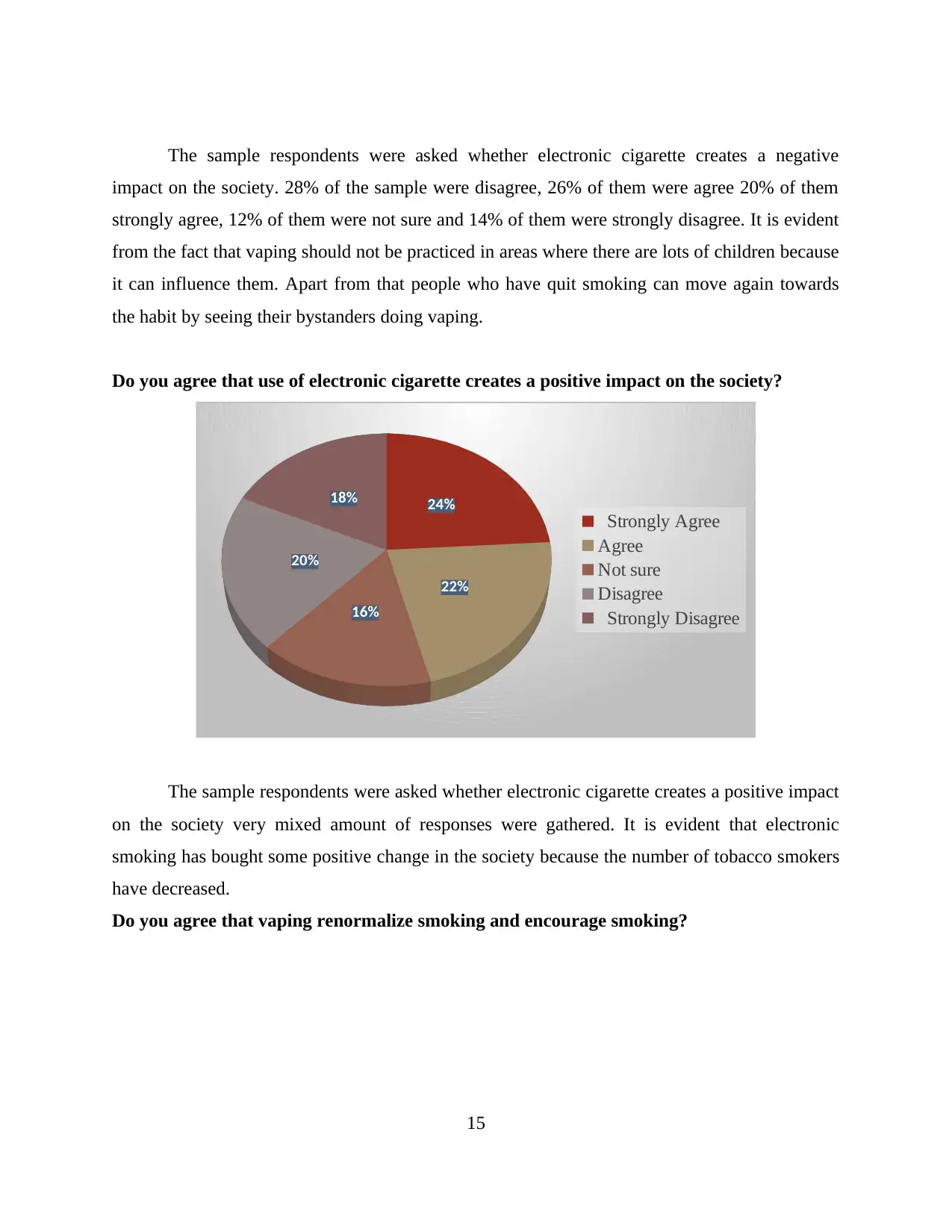
The sample respondents were asked whether electronic cigarette creates a negative
impact on the society. 28% of the sample were disagree, 26% of them were agree 20% of them
strongly agree, 12% of them were not sure and 14% of them were strongly disagree. It is evident
from the fact that vaping should not be practiced in areas where there are lots of children because
it can influence them. Apart from that people who have quit smoking can move again towards
the habit by seeing their bystanders doing vaping.
Do you agree that use of electronic cigarette creates a positive impact on the society?
24%
22%
16%
20%
18%
Strongly Agree
Agree
Not sure
Disagree
Strongly Disagree
The sample respondents were asked whether electronic cigarette creates a positive impact
on the society very mixed amount of responses were gathered. It is evident that electronic
smoking has bought some positive change in the society because the number of tobacco smokers
have decreased.
Do you agree that vaping renormalize smoking and encourage smoking?
15
impact on the society. 28% of the sample were disagree, 26% of them were agree 20% of them
strongly agree, 12% of them were not sure and 14% of them were strongly disagree. It is evident
from the fact that vaping should not be practiced in areas where there are lots of children because
it can influence them. Apart from that people who have quit smoking can move again towards
the habit by seeing their bystanders doing vaping.
Do you agree that use of electronic cigarette creates a positive impact on the society?
24%
22%
16%
20%
18%
Strongly Agree
Agree
Not sure
Disagree
Strongly Disagree
The sample respondents were asked whether electronic cigarette creates a positive impact
on the society very mixed amount of responses were gathered. It is evident that electronic
smoking has bought some positive change in the society because the number of tobacco smokers
have decreased.
Do you agree that vaping renormalize smoking and encourage smoking?
15
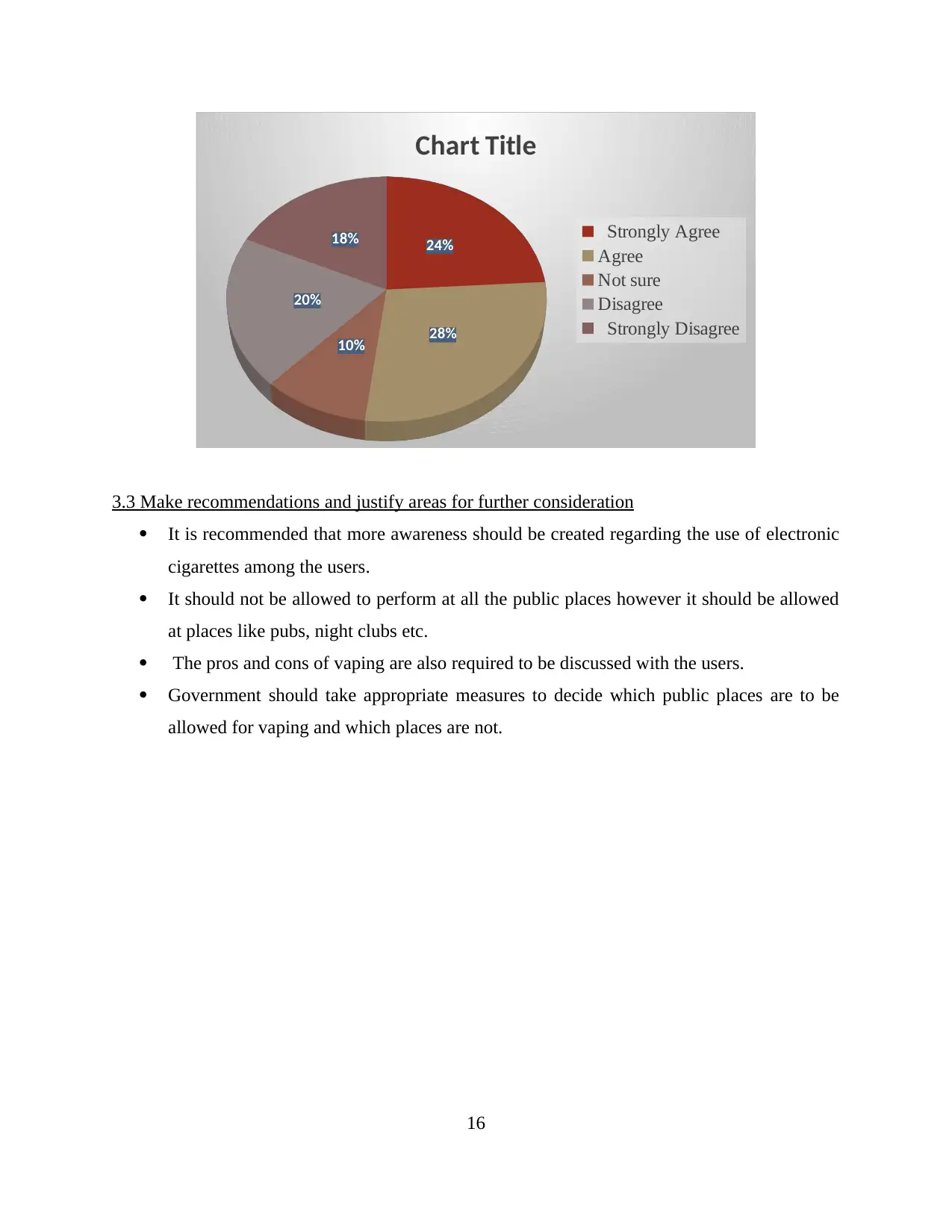
24%
28%
10%
20%
18%
Chart Title
Strongly Agree
Agree
Not sure
Disagree
Strongly Disagree
3.3 Make recommendations and justify areas for further consideration
It is recommended that more awareness should be created regarding the use of electronic
cigarettes among the users.
It should not be allowed to perform at all the public places however it should be allowed
at places like pubs, night clubs etc.
The pros and cons of vaping are also required to be discussed with the users.
Government should take appropriate measures to decide which public places are to be
allowed for vaping and which places are not.
16
28%
10%
20%
18%
Chart Title
Strongly Agree
Agree
Not sure
Disagree
Strongly Disagree
3.3 Make recommendations and justify areas for further consideration
It is recommended that more awareness should be created regarding the use of electronic
cigarettes among the users.
It should not be allowed to perform at all the public places however it should be allowed
at places like pubs, night clubs etc.
The pros and cons of vaping are also required to be discussed with the users.
Government should take appropriate measures to decide which public places are to be
allowed for vaping and which places are not.
16
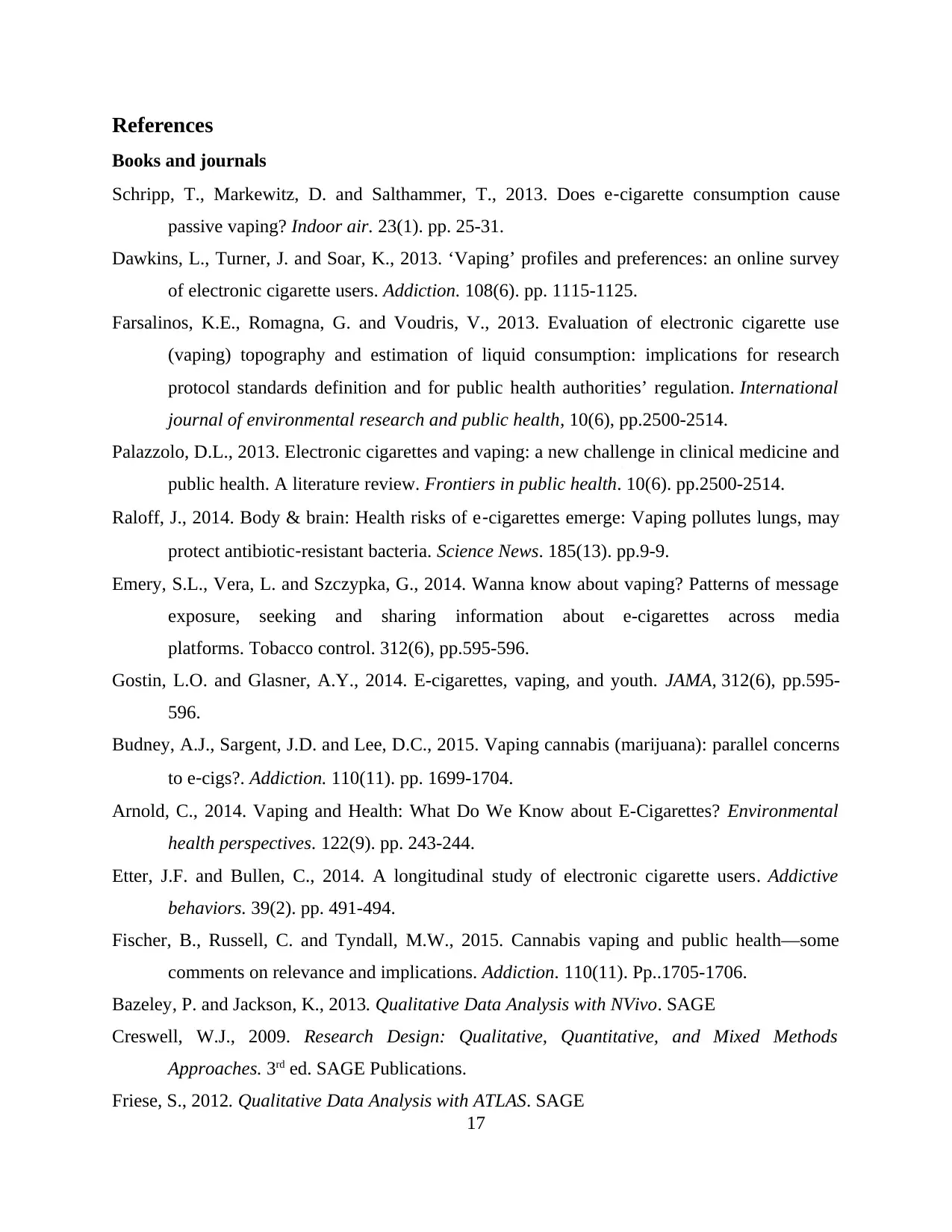
References
Books and journals
Schripp, T., Markewitz, D. and Salthammer, T., 2013. Does e‐cigarette consumption cause
passive vaping? Indoor air. 23(1). pp. 25-31.
Dawkins, L., Turner, J. and Soar, K., 2013. ‘Vaping’ profiles and preferences: an online survey
of electronic cigarette users. Addiction. 108(6). pp. 1115-1125.
Farsalinos, K.E., Romagna, G. and Voudris, V., 2013. Evaluation of electronic cigarette use
(vaping) topography and estimation of liquid consumption: implications for research
protocol standards definition and for public health authorities’ regulation. International
journal of environmental research and public health, 10(6), pp.2500-2514.
Palazzolo, D.L., 2013. Electronic cigarettes and vaping: a new challenge in clinical medicine and
public health. A literature review. Frontiers in public health. 10(6). pp.2500-2514.
Raloff, J., 2014. Body & brain: Health risks of e‐cigarettes emerge: Vaping pollutes lungs, may
protect antibiotic‐resistant bacteria. Science News. 185(13). pp.9-9.
Emery, S.L., Vera, L. and Szczypka, G., 2014. Wanna know about vaping? Patterns of message
exposure, seeking and sharing information about e-cigarettes across media
platforms. Tobacco control. 312(6), pp.595-596.
Gostin, L.O. and Glasner, A.Y., 2014. E-cigarettes, vaping, and youth. JAMA, 312(6), pp.595-
596.
Budney, A.J., Sargent, J.D. and Lee, D.C., 2015. Vaping cannabis (marijuana): parallel concerns
to e‐cigs?. Addiction. 110(11). pp. 1699-1704.
Arnold, C., 2014. Vaping and Health: What Do We Know about E-Cigarettes? Environmental
health perspectives. 122(9). pp. 243-244.
Etter, J.F. and Bullen, C., 2014. A longitudinal study of electronic cigarette users. Addictive
behaviors. 39(2). pp. 491-494.
Fischer, B., Russell, C. and Tyndall, M.W., 2015. Cannabis vaping and public health—some
comments on relevance and implications. Addiction. 110(11). Pp..1705-1706.
Bazeley, P. and Jackson, K., 2013. Qualitative Data Analysis with NVivo. SAGE
Creswell, W.J., 2009. Research Design: Qualitative, Quantitative, and Mixed Methods
Approaches. 3rd ed. SAGE Publications.
Friese, S., 2012. Qualitative Data Analysis with ATLAS. SAGE
17
Books and journals
Schripp, T., Markewitz, D. and Salthammer, T., 2013. Does e‐cigarette consumption cause
passive vaping? Indoor air. 23(1). pp. 25-31.
Dawkins, L., Turner, J. and Soar, K., 2013. ‘Vaping’ profiles and preferences: an online survey
of electronic cigarette users. Addiction. 108(6). pp. 1115-1125.
Farsalinos, K.E., Romagna, G. and Voudris, V., 2013. Evaluation of electronic cigarette use
(vaping) topography and estimation of liquid consumption: implications for research
protocol standards definition and for public health authorities’ regulation. International
journal of environmental research and public health, 10(6), pp.2500-2514.
Palazzolo, D.L., 2013. Electronic cigarettes and vaping: a new challenge in clinical medicine and
public health. A literature review. Frontiers in public health. 10(6). pp.2500-2514.
Raloff, J., 2014. Body & brain: Health risks of e‐cigarettes emerge: Vaping pollutes lungs, may
protect antibiotic‐resistant bacteria. Science News. 185(13). pp.9-9.
Emery, S.L., Vera, L. and Szczypka, G., 2014. Wanna know about vaping? Patterns of message
exposure, seeking and sharing information about e-cigarettes across media
platforms. Tobacco control. 312(6), pp.595-596.
Gostin, L.O. and Glasner, A.Y., 2014. E-cigarettes, vaping, and youth. JAMA, 312(6), pp.595-
596.
Budney, A.J., Sargent, J.D. and Lee, D.C., 2015. Vaping cannabis (marijuana): parallel concerns
to e‐cigs?. Addiction. 110(11). pp. 1699-1704.
Arnold, C., 2014. Vaping and Health: What Do We Know about E-Cigarettes? Environmental
health perspectives. 122(9). pp. 243-244.
Etter, J.F. and Bullen, C., 2014. A longitudinal study of electronic cigarette users. Addictive
behaviors. 39(2). pp. 491-494.
Fischer, B., Russell, C. and Tyndall, M.W., 2015. Cannabis vaping and public health—some
comments on relevance and implications. Addiction. 110(11). Pp..1705-1706.
Bazeley, P. and Jackson, K., 2013. Qualitative Data Analysis with NVivo. SAGE
Creswell, W.J., 2009. Research Design: Qualitative, Quantitative, and Mixed Methods
Approaches. 3rd ed. SAGE Publications.
Friese, S., 2012. Qualitative Data Analysis with ATLAS. SAGE
17
Paraphrase This Document
Need a fresh take? Get an instant paraphrase of this document with our AI Paraphraser
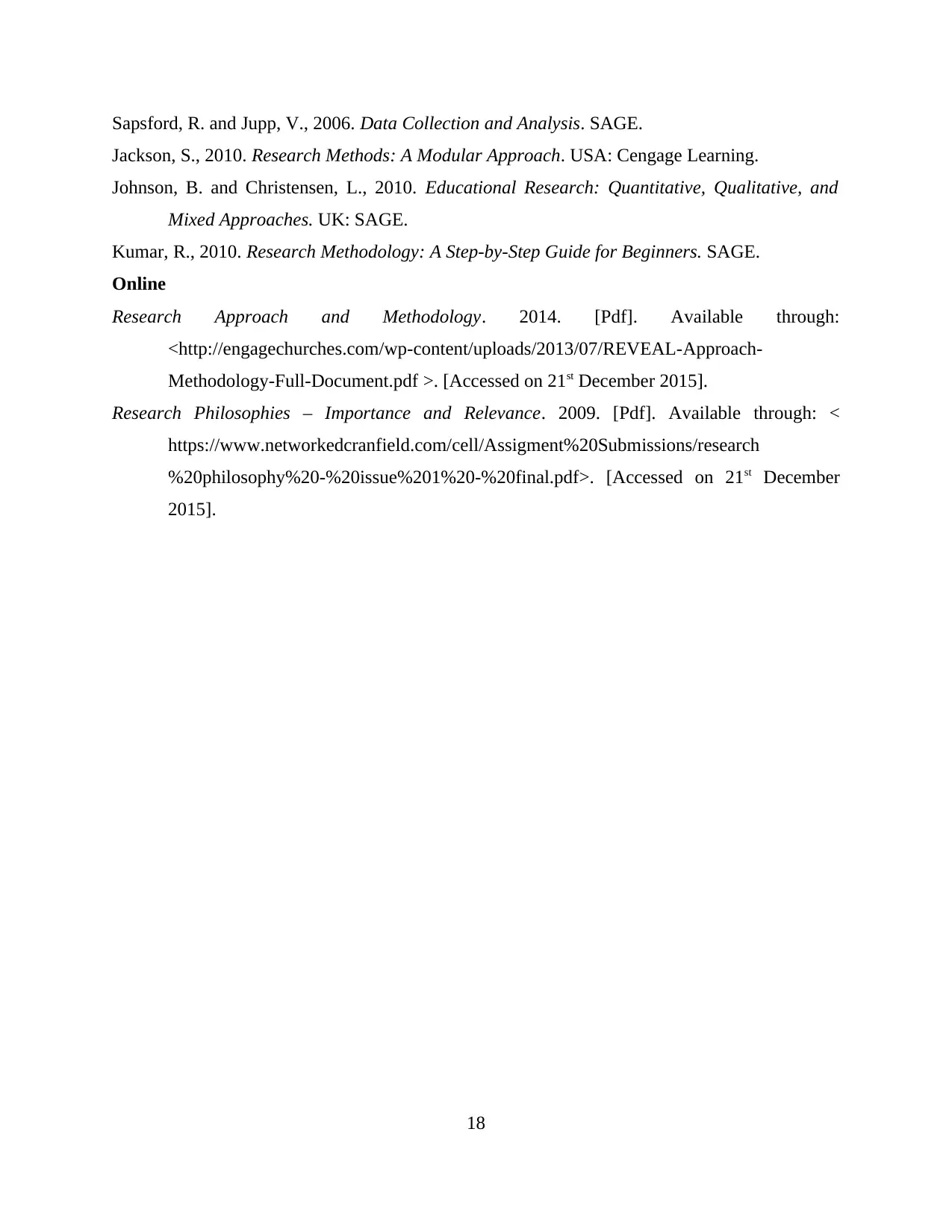
Sapsford, R. and Jupp, V., 2006. Data Collection and Analysis. SAGE.
Jackson, S., 2010. Research Methods: A Modular Approach. USA: Cengage Learning.
Johnson, B. and Christensen, L., 2010. Educational Research: Quantitative, Qualitative, and
Mixed Approaches. UK: SAGE.
Kumar, R., 2010. Research Methodology: A Step-by-Step Guide for Beginners. SAGE.
Online
Research Approach and Methodology. 2014. [Pdf]. Available through:
<http://engagechurches.com/wp-content/uploads/2013/07/REVEAL-Approach-
Methodology-Full-Document.pdf >. [Accessed on 21st December 2015].
Research Philosophies – Importance and Relevance. 2009. [Pdf]. Available through: <
https://www.networkedcranfield.com/cell/Assigment%20Submissions/research
%20philosophy%20-%20issue%201%20-%20final.pdf>. [Accessed on 21st December
2015].
18
Jackson, S., 2010. Research Methods: A Modular Approach. USA: Cengage Learning.
Johnson, B. and Christensen, L., 2010. Educational Research: Quantitative, Qualitative, and
Mixed Approaches. UK: SAGE.
Kumar, R., 2010. Research Methodology: A Step-by-Step Guide for Beginners. SAGE.
Online
Research Approach and Methodology. 2014. [Pdf]. Available through:
<http://engagechurches.com/wp-content/uploads/2013/07/REVEAL-Approach-
Methodology-Full-Document.pdf >. [Accessed on 21st December 2015].
Research Philosophies – Importance and Relevance. 2009. [Pdf]. Available through: <
https://www.networkedcranfield.com/cell/Assigment%20Submissions/research
%20philosophy%20-%20issue%201%20-%20final.pdf>. [Accessed on 21st December
2015].
18
1 out of 20
Related Documents
Your All-in-One AI-Powered Toolkit for Academic Success.
+13062052269
info@desklib.com
Available 24*7 on WhatsApp / Email
![[object Object]](/_next/static/media/star-bottom.7253800d.svg)
Unlock your academic potential
© 2024 | Zucol Services PVT LTD | All rights reserved.




